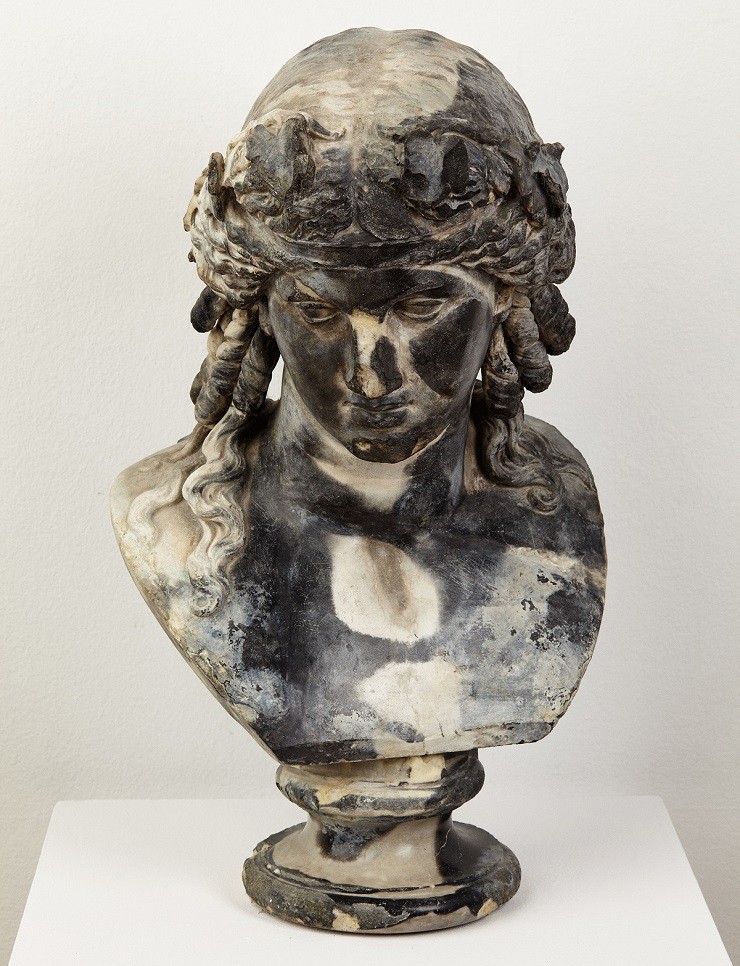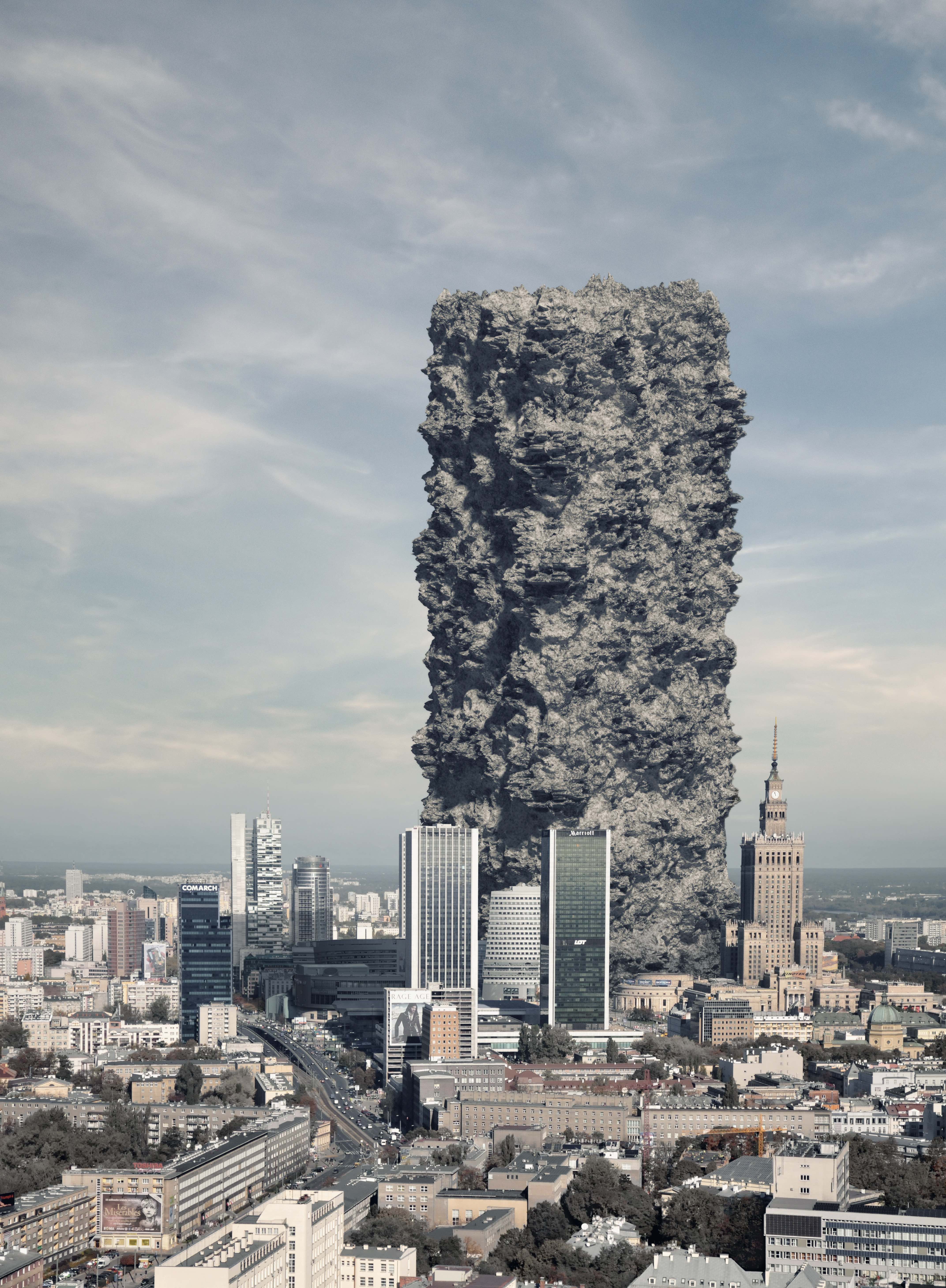III. Warsaw
by Karol Sienkiewicz

Bust from the collection of the von Rose family, recovered from the ruins of the palace at Dylewo. From the exhibition "Estate." Królikarnia, Warsaw, 2015. Photo: Krzysztof Pijarski.
This is an excerpt from Even no. 3, published in spring 2016.
Ruins lay at the heart of three exhibitions in Warsaw last year, one in a decidedly bucolic setting: the 18th-century palace of Królikarnia, which displays sculpture from the National Museum in Warsaw. Królikarnia’s director, Agnieszka Tarasiuk, in collaboration with a team of researchers, artists and curators, put together the exhibition “Estate,” which looked at the history of Dylewo (or Döhlau), a country manor in what was then East Prussia. The estate was owned by the van Rose family, and their vast collection of sculptures, mostly by Italian artist Adolf Wildt, was left behind when the family fled to the West, the Red Army at their heels. Dylewo is now in ruins, and the remains of the sculptures had to be unearthed the same way ancient treasures are excavated. Królikarnia’s exhibition was comprised of these disinterred artworks, organized into a huge installation. The marble heads seemed to have been burned alive. A bronze bust of Dante was consumed by a disconcerting melanoma. A bust of one von Rose fell prey to Russian soldiers, its nose and ears shot off.
These German ruins on (now) Polish territory were juxtaposed with photographs by the Polish artist Zofia Chomętowska. Born to a wealthy family in east Poland, she photographed both peasants in the Polesie region (now within the borders of Ukraine), and the local aristocracy. She even happened to be a guest at the Królikarnia palace before the war, filming the lavish lives of its inhabitants, though by 1944 Chomętowska had to rescue her negatives from the burning city.
The ruins here thus became the context for two nostalgias — German nostalgia for East Prussia (now within the borders of Poland) and Polish nostalgia for Polesie (now within the borders of Ukraine). At the “Estate,” the curators used one room to compare Chomętowska’s photos of Warsaw’s ruins with documents about the history of the Królikarnia palace itself: its destruction, nationalization, reconstruction and conversion into a museum. But any nostalgia for the estate’s past eventually gave way to the acrid present. The dramatic, romantic history of Królikarnia, Dylewo and Polesie may have seduced viewers at first, but the photos and the sculptures, the ruins and the dust, only uncovered their roots in private privilege — something we cannot learn watching Downton Abbey.…

From the exhibition "Reconstruction Disputes," Museum of Modern Art, Warsaw. 2015.
It is symptomatic of this crucial moment in Poland that three art institutions in Warsaw became interested in the same period of history and in its contemporary resonances, in the context of memory, trauma, and social justice. A few years ago, the art historian Piotr Piotrowski called for a “critical museum,” as opposed to the museum-as-shrine or museum-as-entertainment. He defined the “critical museum” as a forum engaged in public debate, an institution forging democracy, one in a state of constant antagonism, and, perhaps most importantly, one capable of asking questions of itself. Piotrowski tried to implement these ideas in 2009, when he was made director of the Warsaw National Museum, but a year later he was forced to resign. (The only example of the museum’s criticality was the 2010 exhibition “Ars Homo Erotica,” a show of gay and lesbian art: a rare occurrence in Catholic Poland.) Piotrowski later wrote: “If museums were part of the process of the formation of democracy, why now — with its development — should they abandon the values which characterize contemporary democracy: its openness to the other, to minorities, to discussion?”
Last October, as these exhibitions of ruins and reconstruction continued, the conservative populist Law and Justice party swept back to power in Poland’s legislative elections. It took only a few weeks for people to take to the streets, worried about the future of democracy, as the new government, led by prime minister Beata Szydło, president Andrzej Duda, and Law and Justice leader Jarosław Kaczyński, attempted to paralyze the constitutional court, rein in the public media, control the internet and monitor citizens. The most damning example of the party’s leadership is its callous response to the refugee crisis in Europe, which the government has tried to ignore, only legitimizing anti-Muslim sentiment. The days when Poland was a beacon of democratic change in central Europe are definitely over.
None of this bodes well for the future, let alone the future of the arts. Szydło, soon after becoming prime minister, openly criticized the film Ida as anti-Polish. The film, which won the Oscar for best foreign film, tells the story of a Catholic nun who discovers that she is in fact Jewish. The controversy around the constitutional court has led the European Commission to launch its first-ever inquiry into the rule of law in a member state. And the new minister of culture and national heritage has announced a new position on cultural policy, focusing on patriotism and the brave history of the Poles (there will be a new Museum of Polish History, no doubt).
The political situation in Poland will be the greatest challenge in the coming years to cultural institutions, which are mostly financed by the state. Theaters, museums, and galleries will be kept under scrutiny, and the days of critical museums may be numbered. Ironically, the Law and Justice party won the election with a fallacious slogan: “Poland in ruins.”